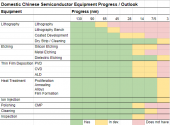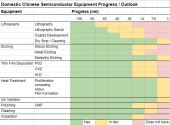Do you have a source for this? First time I hear this.ASML signed agreement to have a certain percentage of US tech inside EUV, not to mention what US could do to Netherland.
You are using an out of date browser. It may not display this or other websites correctly.
You should upgrade or use an alternative browser.
You should upgrade or use an alternative browser.
Chinese semiconductor industry
- Thread starter Hendrik_2000
- Start date
- Status
- Not open for further replies.
Remember, SMIC 7nm was discovered not from SMIC official news (even though they had something like that) but because of some tech publications dissecting a bitcoin miner.Not comparing it to anyone. Just saying they don’t have it. There’s EDA, other ancillary processes but the core components remain foreign. The gap feels like it’s widening
DARPA form a consortium SEMATECH with ASML and TSMC to create and funded an EUVL to challenge the Japanese dominance. Now they want to recreate the same situation with CHIP 4, will they succeed, a big NO, the reason, aside from having a huge market, the Chinese are playing catch up and will employ a whole nation approach like what DARPA did to the Japanese.Do you have a source for this? First time I hear this.
The DOD through DARPA and industry through SEMATECH supported the ... Industry is counting on ASML's EUV lithography tools to restore the pattern of ...
Well Chinese institutions had been developing EUV technologies for quite sometime so ASML should be worry in case of any potential disruption coming from China, having a monopoly on EUV is the only way for ASML to profit from the technology and any competitor will cheapen the technology.China is not able to manufacture DUV systems even remotely competitive with anything ASML sells. While ASML would undoubtedly like to sell its EUV systems to Chinese companies, they most certainly aren't losing any sleep over worries about a potential Chinese EUV rival in the next 5 years.
There's no economic way to leapfrog DUV and go straight into EUV. It took ASML 10 years to go from a EUV prototype to a machine capable of high volume manufacturing. By the time they made the first prototype they were already a market leader in DUV immersion. There are simply too many critical technologies that need to be mastered on DUV before being able to move on to EUV that make leapfrogging attempts a huge risk.
Especially a disruptor like a SSMB.Well Chinese institutions had been developing EUV technologies for quite sometime so ASML should be worry in case of any potential disruption coming from China, having a monopoly on EUV is the only way for ASML to profit from the technology and any competitor will cheapen the technology.
Yes, ASML scanners are made to work with Gigaphoton or Cymer light sources. So in theory with a bit of effort can be make to work with other light sources too. And in theory there could be the option of converting dry scanners into immersion scanners with a lot of effort, but that have to be a collab between ASML, ICRD, CHEERTECH (the immersion part) and the fabs. But I don't know if the effort is worth it because SMEE dual stage scanners are around the conner. But is an option for ASML to keep their China business running.Can you just swapped a component like that?
From a historical perspective, In 2015, the plan of the Sun Yat-sen University to double its computing capacities of the Tianhe-2 supercomputer were stopped by a U.S. government rejection of Intel's application for an export license for the CPUs and coprocessor boards!I expect the next step will be the ban of TSMC advanced foundry services for Biren, Baidu, Alibaba and siblings. It is a necessary step to avoid that the banning of NVIDIA and AMD backfires hugely, as many people here have already pointed out.
Banning TSMC and Samsung for serving Chinese customers is one of the main reasons of Chip 4 Alliance existence and the only thing, together with the banning of ASML EUV, that can be effective in forcing, by 2024-2025, a 2-3 generations gap between Chinese and Western companies.
I really hope that SMIC new 7nm capacity will be big enough, because very soon it will be greatly needed.
After US killed the future of AMAT, LAM Research and in general of US semi equipment in Chinese market, this will mark the end of NVIDIA too. But US administartion seems to have already accepted and even embraced the idea of total decoupling in semiconductor and digital market.
In response to the U.S. sanction, China introduced the Sunway TaihuLight supercomputer in 2016, using domestic processors and architecture, which substantially outperformed the Tianhe-2!
There's a set of western myths that let's a group of people sleep easy at night. However, China is the largest market for semi-conductors, TSMC's ROI gets clobbered every time they can't export something to China. Although, China isn't able to instantaneously create a complete end to end semi-conductor manufacturing supply chain, neither can the US! Imagine the impact on TSMC if all of a sudden Apple its largest customer wasn't able to sell its products in China, there's plenty of non US origin devices that can run wechat, alipay, weibo etc they won't be the shiniest gadgets but so what, the impact on Apple and TSMC's bottom line would be profound, so if its an all out no holds bar fight it will be the Chinese government that will impose the bans, think about that! Its laughable that US Administrations think sanctions are a unidirectional winning strategy when it is to use the Chinese allusion simply a way of 'lifting a stone to drop on your own feet'.
On the whole the Chinese government has a country to run so could do without the distractions, same can't be said of the US government which doesn't seem to care much about running their own country and much more interested in ruining other people's!
The drive to make components with ever smaller features only affects a tiny part of the overall technology landscape, all the talk of 'generations' masks the underlying truth that for the majority of tasks equipment from a couple of 'generations' ago are already more than good enough, my wife had her phone stolen a while back so she's been using an old Oneplus 3 we have lying around, while she figures out what to get next, surprise surprise it does everything she needs it to do so she ended up dragging her feet on getting a replacement!
Non of the US technology bans have stopped China from implementing its plans to modernise the country and move its technology base forward, the arms export ban didn't stop them creating aircraft carriers and stealth fighters, the NASA ban didn't stop the space station, moon and mars rovers and so on so forth.... The bans mainly hits private commercial Chinese enterprises' ability to maximise profits, but then the Chinese government periodically 'corrects' the 'imbalances' in the profit generation of its private enterprises anyway, so its already baked in to the system!
CanSemi starts capacity expansion for analog chips at 12-inch fab
China foundry CanSemi Technology has recently kicked off its third-phase expansion plan at its 12-inch wafer fab in Guangzhou, southern China with total investment of CNY16.25 billion (US$2.355 billion), aiming to build specialty process platform for analog chips for industrial and automotive applications.
After the third-phase facility construction is completed in 2024, CanSemi's monthly capacity will increase by 40,000 pieces to a total of 120,000 in 2025, with production processes to advance to 55-40nm and 22nm.
The company started first-phase production in December 2017 adopting 180-190nm processes for MCUs, power management ICs, analog chips and discrete power chips, and the second-phase capacity entered volume production in the first half of 2022, progressing to 90-55nm process nodes.
CanSemi said its third-phase capacity will be mainly for producing power electronics, server chips, power devices for 5G infrastructure and automotive applications and signal chain ICs in addition to MCUs, PMICs and image sensor chips, aiming to help build a semiconductor cluster in the Guangdong-Hong Kong-Macao Greater Bay Area (GBA) in line with China's 14th Five-Year Plan.
Its president and CEO Chen Wei has said that there are many noted tech players operating in the GBA, such as handset vendors Huawei, Oppo, Vivo and ZTE, smart household appliances brands Midea, TCL and Gree, car vendors BYD, XPeng Motors and Guangzhou Automobile, as well as new energy startups, forming a huge application market for chip products. The entire GBA currently accounts for 50% of chip consumption in China, according to Chen.
- Status
- Not open for further replies.


